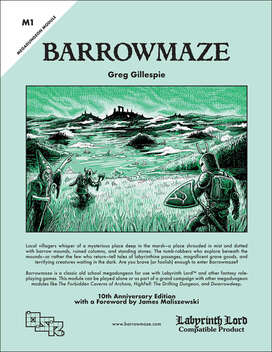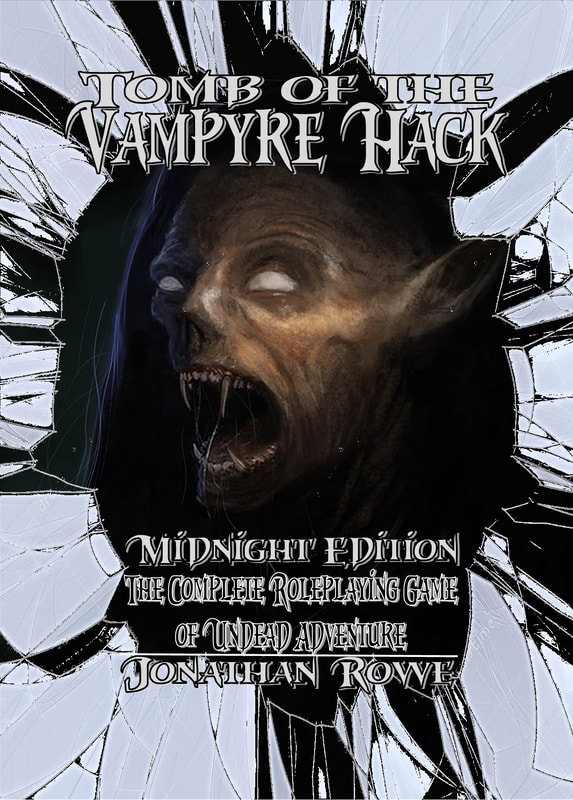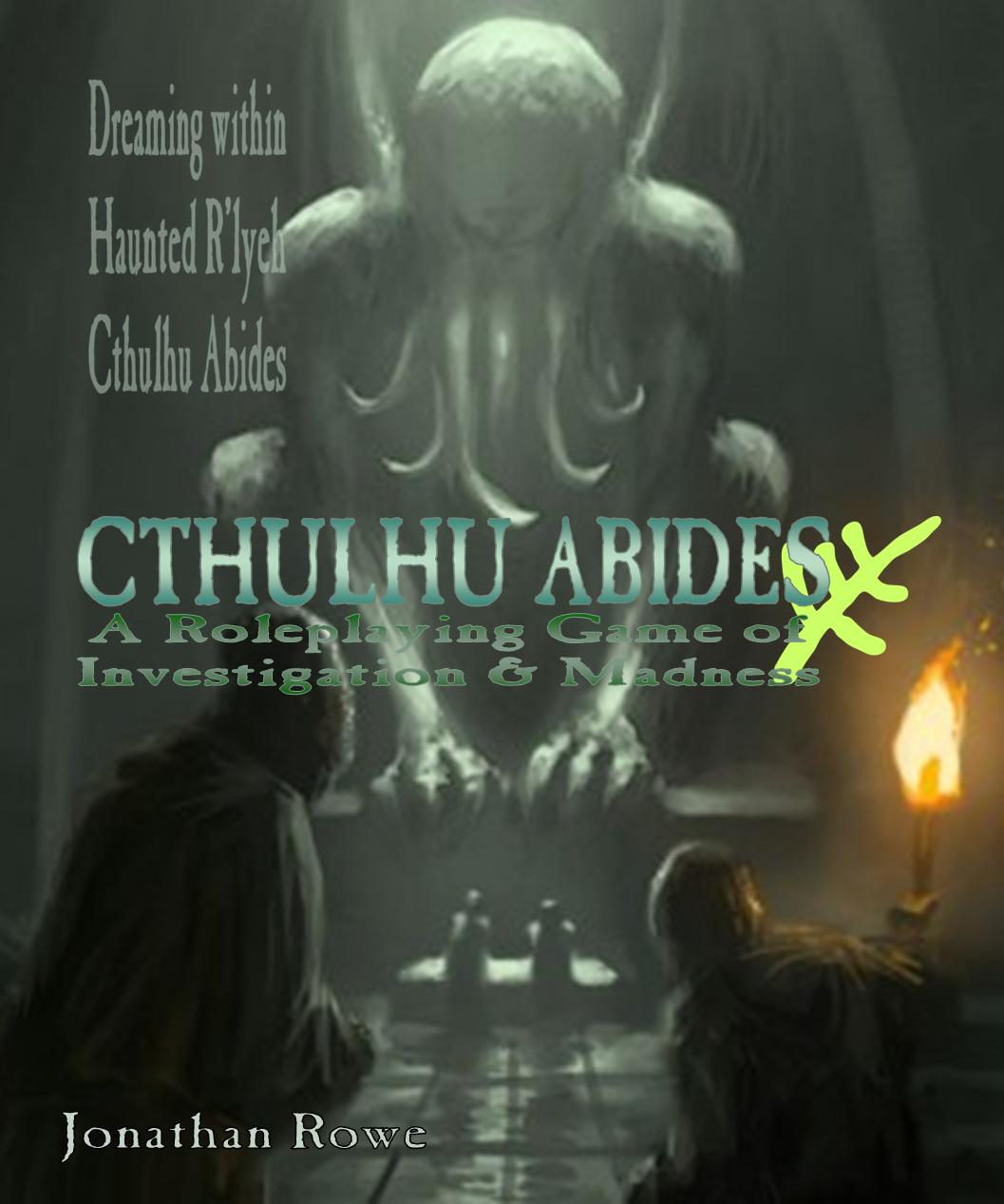|
A challenge has been laid down! We're going to delve into Barrowmaze. But we're not using AD&D or Labyrinth Lord or even sleek little White Box FMAG, oh no. No, we're going to use our beloved fantasy heartbreaker Forge: Out of Chaos (see blogs passim, or here). Very minor spoilers ahead for the village setting in the Barrowmaze adventure. Wait - what? Barrowmaze?Barrowmaze is a megadungeon, published in 2011 by Greg Gillespie, who has built a career out of designing, publishing and running college courses on these vast dungeons. With over 600 detailed rooms, the Barrowmaze dungeon is designed to be the sort of thing you walk into as 1st level noobs and walk (or crawl) out of again, months or even years later, as high level heroes. It's an entire campaign in one dungeon complex, plus its equally well detailed environs. Modern cover and charming old school monochrome cover. The links are to Labyrinth Lord (OSR) editions but there are 5th ed D&D versions as well. Barrowmaze has an interesting structure, because it doesn't descend deeper into the earth through levels of increasing toughness, hostility and reward. Instead, the vast underground complex sits below a surface level Barrowmoor where the landscape is dotted with 70 barrow mounds. Each of these is a stand-alone mini or micro dungeon and a half dozen of them are access points for the Barrowmaze below. As you travel further into the Moor, the barrows get nastier and more lucrative to raid and the Maze below features more awesome monsters and treasures. In theory it's possible for lucky and reckless novice adventurers to proceed directly to the further extent of the Moor and discover an access point to the most perilous part of the Maze, where the Big Bad Evil Guy(s) are waiting. But we won't be doing that now, will we guys. Guys? So, seriously ... Forge?If you've followed this blog, you'll have come across my advocacy of this late-'90s indie RPG before. It's part of a stable of indie products that emerged in the dark days before Print On Demand and which collectively represented a sort of proto-OSR movement, celebrating dungeon bashing even as the hobby was moving in moody, exotic and cerebral directions in the wake of games like Vampire: The Masquerade and D&D projects like Planescape. Forge can be criticised for being derivative of D&D in the areas where it isn't innovating. But that's a good thing if it means that Forge's combat system, magic and adventuring assumptions map quite nicely onto the 1st Edition D&D/Labyrinth Lord rules undergirding Barrowmaze. I've even got a Forge/D&D monster converter on this website. Where Forge does diverge from D&D is in its setting: a world where the gods are all dead or exiled, there are only two types of 'cleric' and there are several unusual options for PC races (or is it species? well, you know what I mean!). Forge gives us fairly conventional Elves and Dwarves and its Sprites are essentially Halflings with magical empathy powers. Gigantic one-eyed Ghantu and pig-faced Higmoni fill the orc/half-orc slot. Berserkers are goliaths (but Forge predates their appearance in 3.5ed D&D). Next up, the oddballs. The sun-fearing albino Dunnar have innate magic detection, but look creepy and shuffle awkwardly. Then there are the animal-inspired lineages. The weasel Jher-em have prehensile tails and terrible asthma. The scaly Kithsara are innately magical. Bird-person Merikii are ambidextrous but, alas, cannot fly. Adapting the Setting: HelixHelix is the village on the edge of Barrowmoor that is the jumping off point for adventurers. Its name is odd, but probably suits the vaguely SF Forge better than the trad fantasy D&D. Author Greg Gillespie is very fond of exploring religious allegiances and conflicts in his settings, notably between the New Gods of civilisation and the Old Gods of the wilderness and the earth. An important deity is Nergal, the death god murdered by his demonic sons and whose cult built the vast funerary complex of Barrowmaze. Helix has a new shrine to St Ygg, one of the civilised gods of light and law, but many locals still venerate Herne the wilderness god at a nearby stone circle. Forge also has a 'dead' death god - Necros - and two more gods who are literally in Hell, but all the other gods have been banished by the wrathful (but strangely distracted) supreme being Enigwa. I've got a detailed analysis of Forge's unusual mythopoesis here. It's straightforward to treat Nergal as Necros, which makes the Barrowmaze a site that pre-dates the God's War, from a time before Necros turned to utter villainy. St Ygg has clear corollary with Forge's Berethenu, the god of Law and Justice with magical healing magic and a mission to exterminate Undead - who is currently burning in Hell. But it might be more interesting to link St Ygg instead with the worship of Enigwa the Supreme Being. Enigwa's religion could best be described as Deism: the belief in an all-powerful and moral creator who does not answer prayers, grant revelations or intervene in the world he has made. In Forge's world, this sort of religion would promote Humanism, education, self-reliance and philanthropy. We know that Enigwa forbade teaching magic to mortals; author Mark Kibbe's other books describe the Church of Enigwa persecuting mages. This makes sense if the Church of Enigwa is promoting science, reason and community enterprise over superstition, magic and individual glory. A very worthy religion indeed and one you could imagine running a small school and infirmary in Helix. No healing magic from Brother Othar and his acolytes though - but presumably high levels of medical expertise. Who or what then is being worshipped over at the stone circle three miles outside town? It makes sense that Grom the (also Hell-bound) war god might have been someone the villagers turned to for defence before the Church of Enigwa turned up. Perhaps Brother Othar drove out the Grom Warriors who lorded it over this place, but villagers are still inclined to call on Grom when some undead horror shambles out of Barrowmoor. Education and Humanism are lovely things, but sometimes you need a sword reeking of hot blood. In a setting like this, virtuous Berethenu Knights must keep a low profile and perform their healing magic discretely. Valeron the Elf is likely to be such a one. Perhaps the Church of Enigwa looks the other way if Berethenu Knights donate their charitable tithes to the local school and infirmary. But if a Pagan Mage draws attention to herself with public magic use, Brother Othar will petition Lord Ironguard have that Pagan fined, put in the stocks or even gaoled in Ironguard Motte. Actually, he'll petition the Jher-em vizier Ollis Blackfell (why make him Jher-em? well Ollis is described as "a weasel-looking fellow"). I think I'll turn the local magic-user Mazzahs the Magnificent into a Kithsara Enchanter. My take on these lizardfolk is that their cold bloodedness makes them philosophical and scholarly by nature. Mazzahs teaches occasional classes at the school in return for being left alone to practise Enchantment - but he can't afford to advertise his magic too loudly. That will do for now. I'll post up session reports for the exploration of Barrowmaze and also how Forge fares as a surrogate rules set for this sort of mega dungeon bashing.
0 Comments
Leave a Reply. |
30 Minute Dungeons
Essays on Forge
FORGE Reviews
OSR REVIEWS
White Box
THROUGH THE Hedgerow
Fen Orc
I'm a teacher and a writer and I love board games and RPGs. I got into D&D back in the '70s with Eric Holmes' 'Blue Book' set and I've started writing my own OSR-inspired games - as well as fantasy and supernatural fiction.. Archives
July 2024
Categories
All
|






 RSS Feed
RSS Feed
























